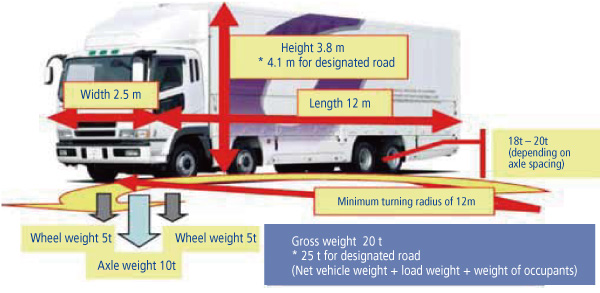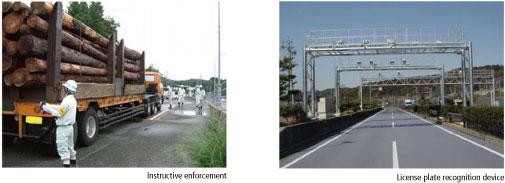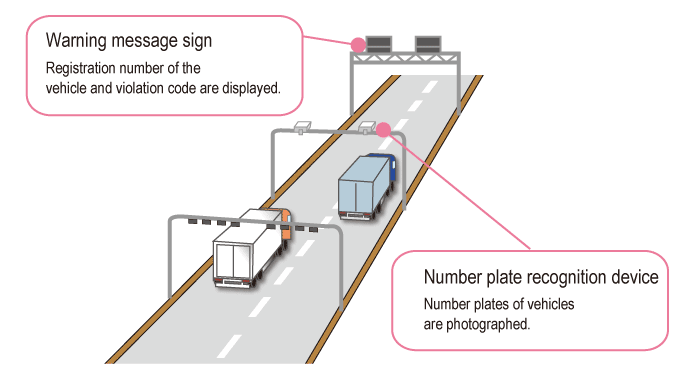Vehicle size and weight
Road-related Systems in Japan
Roads are designed to ensure safe and smooth traffic for
vehicles with certain specifications. In principle, vehicles that
do not meet size and weight requirements are not allowed to
be on the road, because they can potentially damage the
road’s structure or disrupt traffic.
However, road administrators are empowered to give permission
to the vehicles that exceed the size or weight regulations
to use the road, but only if the road administrator acknowledges
that there are no alternatives after examining the
vehicle’s structure and the cargo. In these cases, the road
administrator will put certain conditions in place to protect the
road structure and prevent potential dangers to road users.
■On general roads
General limit (upper limit) of vehicles according to Article 3.1, Vehicle Size and Weight Restriction


■On expressways
Dimension & weight limits for specifiedvehicles are more lenient than on general roads
| Length | |
| Semi-trailer | 16.5m |
| Full-trailer | 18.0m |
| Greatest axle distance | 8m or more | 9m or more | 10m or more | 11m or more | 12m or more | 13m or more | 14m or more | 15m or more | 15.5m or more |
| Gross weight | 25t | 26t | 27t | 29t | 30t | 32t | 33t | 35t | 36t |

Approval system for the use of special vehicles on roads
Road administrators are authorized to permit the drivers of vehicles that exceed the size or weight regulations to use the road, but only after the road administrator examines the vehicle’s structure and the cargo and determines that there are no alternatives. In these cases, the road administrator will put certain conditions in place to protect the road structure and to prevent any potential dangers to other road users. Road fatigue, which is caused by vehicle traffic that is over the weight or size regulations, has a significant effect on road structures and pavement. In order to utilize our road stock effectively in the future, it is important to ensure that road structures are properly maintained now.
Controlling illegal vehicles
1. Instructive enforcement
Drivers are told to pull over at "instruction stations", where
vehicle weights and sizes are measured. If the vehicle exceeds
the size or weight regulation, the drivers are ordered or warned
to reduce the weight and size of the vehicle by splitting the
cargo.
2. Weigh-in-motion (WIM)
A WIM device automatically measures a vehicle’s gross weight
as the vehicle drive over a measurement site. If the vehicle is
over the weight regulations, it then determines if the
overweight vehicle has a permit by accessing the database.
Based on the results, repeated violators will be given an
instructive warning.

■Weigh-in-motion

